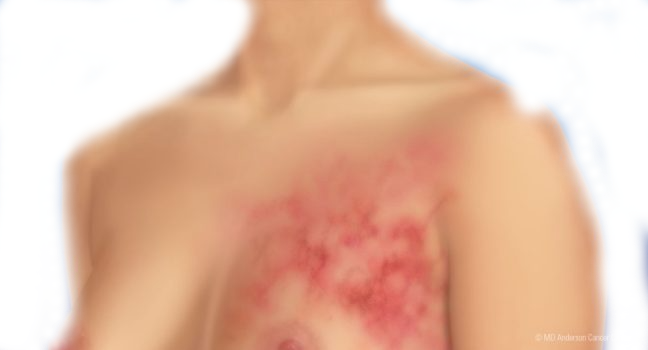what is inflammatory breast cancer ?
A heavy, sensitive, or heated breast is another symptom of inflammatory breast cancer. Possible symptoms include discomfort, burning, or itching. In most cases, the affected area of skin is at least one-third of the breast; nevertheless, certain rashes more closely resemble tiny insect bites. An early inflammatory breast cancer rash could manifest as a little skin change on the breast that develops quickly over a few weeks, or it could look like a constant bruise.
Breast cancer is a condition where damaged breast cells proliferate and develop into tumours. Tumours can become deadly if they proliferate throughout the body and are not treated. Inside the breast’s milk ducts and/or milk-producing segments are where breast cancer cells first spread. It is not fatal to deal with the earliest form (in situ). Cancer cells have the ability to spread through neighbouring breast tissue. Tumours produced by this result in lumps or thickening. Cancers that affect organs have the ability to metastasis, or spread to neighbouring lymph nodes. Fatal tumours are possible. Therapy is determined by the patient, the kind of cancer, and how far it has spread. Treatment consists of radiation therapy, surgery, and medication.
Symptoms of inflammatory breast cancer
1.One-third of your breast may have a rash, bruise, or discoloured patches that are red, pink, or purple.
2.Your breast skin may get pitted, dimplified, or thicker, giving it an orange peel appearance.
3.One breast’s hardness or tenderness, pain, swelling, or itching.
4.One breast swollen, scorching, warm, or heavy.
5.A retractable or inverted nipple is one that points inward.
6.swelling lymph nodes under your arm or close to your collarbone.

causes of breast cancer
1.Breastfeeding mothers are more likely to have the excruciating swelling of their breasts, known as mastitis. However, it can also affect any woman or anyone who is classified as female at birth (AFAB), especially if she smokes or has diabetes.
2.A bacterial infection beneath the surface of your breast can result in a build-up of fluid called a breast infection. Breastfeeding mothers are frequently affected with breast abscesses, which can result from untreated mastitis. Mammary duct ectasia is the most common cause of breast abscess in non-breastfeeding individuals.
3.When your milk ducts enlarge, you can develop a disorder called mammary duct ectasia. Debris in these milk ducts has the potential to become contaminated.
4.A rare kind of breast cancer that affects about 1% to 4% of all instances, paget disease of the breast begins in the nipple and can spread to the areola, the black skin surrounding the nipple. The majority of patients also have an underlying breast lump carrying cancer.
Cancerous cells are discovered in the outermost layer of the skin on your areola and nipple when you have Paget’s disease of the breast. Whether cancer cells from tumours inside your breast move through your milk duct and land on your nipple or if cancer can grow in your nipple alone is still unknown.
Diagnosis of breast cancer
- Biopsy: (taking out a sample of the breast tissue)
The only method that can be used to diagnose breast cancer with certainty is a biopsy. Using an X-ray or other imaging test as guidance, a specialised needle device is utilised to remove a core of tissue from the worrisome location during a biopsy. In order to ascertain whether the cells in a biopsy sample are cancerous, the type of cells involved in the breast cancer, the aggressiveness (grade) of the cancer, and whether the cancer cells have hormone receptors or other receptors that could affect the treatment options, the biopsy samples are sent to a laboratory for analysis. - magnetic resonance imaging (MRI) of the breast
A magnet and radio waves are used by an MRI machine to produce images of the breast’s interior. A dye injection is done prior to the MRI. Radiation is not used in an MRI to produce the images.
Various tests and procedures could be employed based on the specific needs. - ultrasonography of the breast
Sound waves are used in ultrasound to create images of internal body structures.
This examination can be utilised to distinguish between a fluid-filled cyst and a solid mass in a newly discovered breast lump.

Treatment of breast cancer
Many techniques are used to treat breast cancer. The type and extent of breast cancer will determine how far it has spread. Patients with breast cancer frequently receive multiple types of treatment.
- Surgery. an extraction procedure wherein the malignancy is removed.
Chemotherapy. using certain medications to either shrink or eradicate cancer cells. The drugs can be administered intravenously (IV) or as pills, or occasionally both. - hormone treatment. prevents hormones that cancer cells require for growth from entering the body.
- biological treatment. collaborates with the immune system in your body to help it combat cancer cells or manage the adverse effects of other cancer treatments.
- radiation treatment. applying X-ray-like high-energy radiation to destroy the cancer cells.

